Rabbits are fastidious groomers, and it’s natural to occasionally find them pulling on their own fur or that of other rabbits. However, rabbits may sometimes develop an abnormal grooming habit that makes them pull out too much fur.
You may then wake up one morning to your bunny with bald patches or inflamed skin – which may leave you wondering in frustration, “why do bunnies pull their own fur?” It’s a complex question, and there are several possible reasons. Some of these are no cause for alarm, but others may warrant a visit to your vet.
In this comprehensive guide, we’ll cover everything you need to know about fur pulling in rabbits, including:
- Reasons why rabbits pull out their own fur, or that of their friends
- How and why fur-pulling can be dangerous for rabbits
- What to do if your rabbit keeps pulling its fur, and when to bring it to the vet clinic.
Why Is My Rabbit Pulling Fur Out?
Rabbits may pull or pluck out their fur for several reasons, including if they are molting or pregnant. However, excessive hair pulling may be due to stress, itchy skin from parasites, or even a nutritional imbalance. It’s important to understand when fur pulling is normal, and when it warrants a visit to the vet.
6 Reasons Why Rabbits Pull Out Their Fur
While fur pulling may sometimes be considered normal rabbit behavior, other times, it may be a sign of discomfort or an underlying medical condition.
Here are a few reasons why you may find your rabbit pulling out its fur:
Pregnancy
Nesting is one of the foremost causes of fur pulling in female rabbits. If notice your rabbit pulling fur from her dewlap, belly, or flank, then she’s probably pregnant. Fur pulling in this case is normal maternal behavior, as she is trying to line a nest for her kittens. A pregnant doe may also gather hay, leaves, and other bedding materials to build her nest.
Fur pulling in pregnant rabbits is driven by hormones and shouldn’t cause her pain or discomfort. It also shouldn’t make the underlying skin look inflamed.
A false pregnancy (pseudopregnancy) may be another cause for fur pulling in unspayed female rabbits. This may happen if your rabbit is mounted by a dominant female rabbit or a neutered male rabbit.
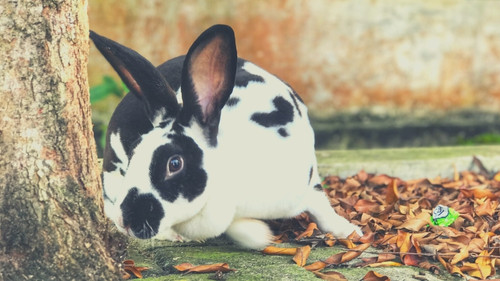
Although she isn’t pregnant, your bunny’s body believes she is, and she’ll display typical maternal bunny behavior. Her belly and mammary glands may enlarge, and she may also pull out fur to line a nest.
Generally, a false pregnancy may last 16 to 18 days, after which your pet’s behavior goes back to normal.
Spaying your rabbit will prevent pregnancies, both real and false! Additionally, spaying rabbits reduces the possibility of reproductive cancers. It is also a good idea to neuter male rabbits if you have no plans of breeding them.
Boredom and stress
Rabbits sometimes pull their fur when they are bored, stressed, or even scared. If your rabbit lives alone in a tiny space or hutch, it’ll get bored and resort to fur pulling just for want of something to do.
Rabbits need space to run, jump, dig, and just do typical rabbit activities. Rabbits are social animals and need companionship. It is a good idea to keep two rabbits together, especially if they are a bonded pair.
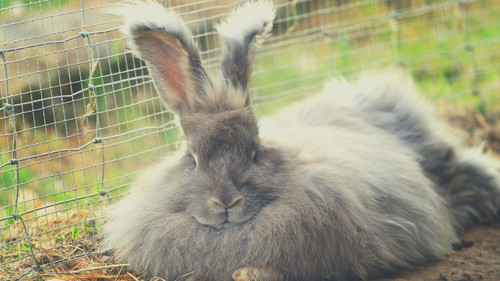
Bright lights, loud noises, and an overcrowded environment can stress a rabbit and cause it to pull its fur out. Additionally, fur pulling in rabbits may be due to fear, typically because a cat, dog, or some other predator is able to get near.
Grooming
You may also find rabbits pulling hair out during molting. Your pet may lose a lot of fur during shedding periods, especially as they throw their winter coat in preparation for warmer temperatures. Rabbits are good groomers, and short-haired breeds usually require little help during the shedding period.
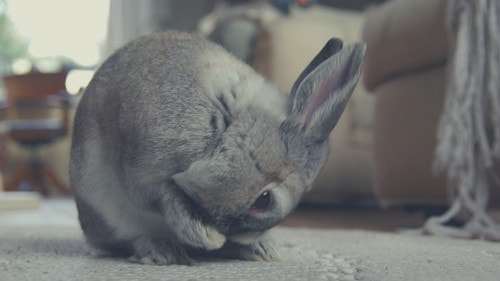
Tangled or matted fur is another cause for fur pulling in rabbits, especially in long-haired rabbits. Rabbits have sensitive skin, which can get itchy and sore underneath mats, causing them to over-groom and pull out their fur.
Dietary imbalance
A nutritional imbalance may also make rabbits pull their fur and ingest it. They do this when their diet lacks enough fiber, in which case, they turn to their fur as an additional fiber source.
An ideal rabbit diet should be rich in fiber, as it eases gut movement and keeps the digestive tract healthy.
Parasites
A parasitic infection often causes skin discomfort in rabbits. It makes them itchy and causes them to pull their fur in an effort to ease the itch. Sometimes, your bunny may pull their fur so hard that you may notice bleeding patches.
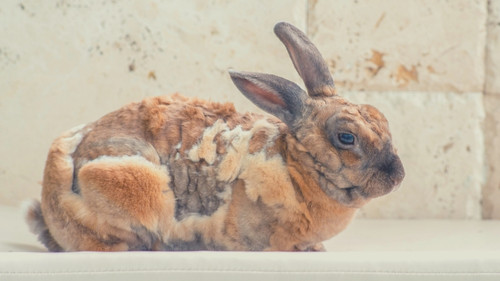
Common rabbit parasites include fleas, lice, fur mites, and ear mites. If your pet rabbit is infected with parasites, you’ll notice it scratching or rubbing itself on hard surfaces in addition to pulling fur.
Most flea treatments for cats and dogs aren’t safe for rabbits, but you can get rabbit flea treatment from your vet.
Why is my rabbit pulling out other rabbits’ fur?
Rabbits naturally nibble each other’s fur while they groom, so small amounts of fur may come loose in this process. However, if your rabbit is aggressively pulling out their hutch mate’s fur, it is usually a sign of dominance, known as barbering.
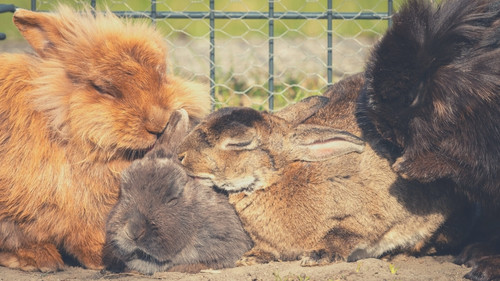
You are likely to witness rabbit barbering if two or more rabbits live in the same hutch or environment. Rabbits are social animals and immediately establish a hierarchy amongst one another. Rabbits will fight or pull one another’s fur until one emerges dominant. Sometimes, even when the hierarchy is established, the dominant rabbit continues to fight, mount, chase, or barber the submissive rabbit just to show who is the boss.
If you notice this typical dominant behavior, consider separating the rabbits temporarily. You may then gradually introduce them later.
Dangers When Rabbits Pull Fur Out Excessively
While pulling fur is sometimes normal behavior in rabbits, there are some potential risks associated with rabbits pulling their own hair or that of another rabbit.
Skin issues
Sometimes rabbits pull more fur out than normal when they groom themselves. Grooming problems could result in issues like a patchy coat, red inflamed skin, bleeding, and skin infections.
When rabbits fight, they may pull out the submissive rabbit’s fur aggressively, which can also damage the skin.
Gastrointestinal problems
Another issue every rabbit owner needs to be aware of when it comes to hair pulling in rabbits is the formation of hairballs or trichobezoars.
It is normal for rabbits to ingest a little fur while grooming themselves. Usually, it comes out undigested, strung with their poop. However, if your bunny ingests too much fur, it could predispose them to hairballs.
Hairballs could get stuck in your rabbit’s digestive system and could result in gastrointestinal problems like GI stasis. This is an obstruction of the digestive tract and could be fatal if left untreated.
Additionally, a blockage of the digestive tract could cause it to rupture, resulting in peritonitis.
This is an infection of the lining of the digestive system and is also potentially fatal. Typical symptoms of gastrointestinal problems include signs of pain like teeth grinding, appetite loss, weight loss, lethargy, and reduced poop volume.
How Do I Stop My Rabbit From Pulling Out Its Fur?
While seeing a little rabbit fur in the hutch is not a cause for alarm, it is best to prevent your pet from over-grooming or pulling out too much fur. Observe your pet to see if you can determine the cause of your rabbit’s hair pulling so that you can address it effectively.
Here are a few pointers on what to do if your rabbit is pulling out its own fur.
Regular grooming
Giving your pet rabbit a good brushing is a good way to prevent it from excessively pulling out its own fur. This is especially important during molting, as bunnies may need help with grooming areas they can’t reach easily.
It is advisable to groom your pet weekly if it’s a short-haired breed and daily if it’s a long-haired one. This will help reduce the risk of skin infections and strengthen the bond between you and your pet.
However, unlike dogs, you should rarely, if ever, need to bathe your bunny.
Provide for its basic needs
Another thing to do if you notice your pet rabbit pulling its fur is to ensure it is comfortable. Provide all the basic bunny needs like a balanced diet, fresh water, toys to keep it busy, and a spacious enclosure.
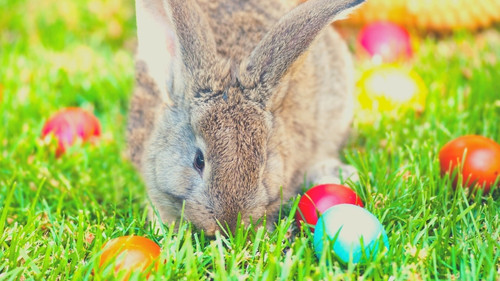
If you suspect your pet is stressed, consider removing all stressful factors. Rabbits are a prey species, so it is a good idea to keep them out of reach of cats, dogs, or other predator species. If your rabbits are fighting with each other, you could keep them in separate hutches to prevent the risk of injuries.
Visit your veterinarian
Excessive fur pulling in rabbits can be alarming. If your rabbit doesn’t stop pulling its fur after implementing all the measures above, there may be a medical reason and you should consult your vet. If your rabbit develops raw, bleeding patches of skin, a vet can prescribe medications to help it heal.
Consult your vet immediately if your pet shows abnormal behavior like signs of pain, lethargy, weight loss, and appetite loss.
Conclusion
Sometimes, your rabbit pulling its fur might be a normal bunny behavior, other times it may be due to an illness, stress, nutritional imbalance, or even boredom. Regularly brushing your rabbit and providing all its basic needs is a good way to prevent excessive fur pulling. Always check with your vet if your rabbit’s grooming is damaging their skin or seems excessive.
If you have enjoyed this article, share it with your fellow rabbit owners, and if you have any questions about your pet, leave them in the comments section below.


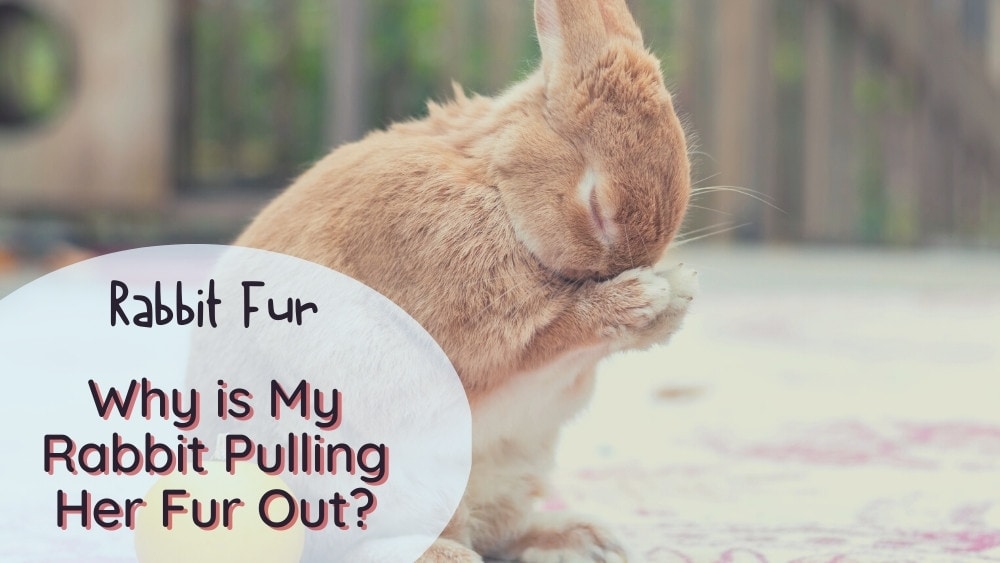
Hi Kathryn,
With much pain and grief I am writing this to you hoping that I can at least have an answer for the likely cause of my lion head rabbit ( 3 yrs old ) which died suddenly on Monday (17/4 /time 2:30pm ) . My lion head rabbit ( Bumbit) was a hyperactive and intelligent rabbit which displayed a characteristics almost of that like a dog in close communication / via her behavior. It was on Monday morning 7am that she was biting vigorously on her cage wanting attention . Immediately she jumped out from the cage through the top door opening and dashed to our TV room which was her daily favorite roaming ground . I noticed that she was pulling out a lot of her fur at 10am and there was so much poop all over the room even on the bed which is not the usual size ( She would poop only a few occasionally and not like this much in the room ) . This abnormal behavior ( pulling out fur ) began to raise an attention to us altought she has done it before when she was pregnant at 2 yrs old . ( for your information, we send her twice in a month ( 5 days each ) to boarding when we travelled overseas ( just about 5 weeks ago -1st trip) / 2 week ago -2nd trip ) interval of 10 days apart ) She hid herself in the bedsheet overlap to cuddle with her fur with her limps digging continuously. We would come in to check on her from time to time thinking she is playing out of boredom . I fed her with fresh vegetable around 1pm which she ate 3/4 from the lot ( she was eating well even before this ) . However , our biggest nightmare happened when my wife came in around 2:30pm only to see her lying dead on the edge of the door . We were completely devastated and in tears which we cannot comprehend what has gone wrong . We noticed that there was blood stain on her anus and mouth area and her eyes were opened wide . At present , we are still mourning over the sudden loss of our favourite rabbit ( we have 3 in total ) and will very much like to know at least what could have likely happened to her . We sincerely hope that you can provide us with a likely cause or a clue of what might have occurred resulting in the sudden death . Please write to us based on your profession experience / expertise knowledge so that we may at least know what went wrong in that day . If you may need any further information, we will be glad to answer any . . We are waiting for your reply so that we may rest with her in our thoughts . Thank you.
Hi Richard. Firstly, I want to express my condolences for the loss of Bumbit. It is clear from your message how much she meant to you and your family, and her death must have been a shock. I can also understand you wanting to know what happened, especially with other rabbits in the family. It’s very difficult to say for certain why she died, but I would say there are two possibilities that jump out. One would be that the behavior of pulling her fur out and digging in a “den” in the bedsheet does sound like the kind of behavior we see in pregnant or pseudo-pregnant animals. As you may be aware, there are also potential health risks with pregnancy such as mineral imbalances and sepsis, both of which can lead to sudden death. The other thing to consider is the possibility of viral involvement, as viruses are the leading cause of sudden death in rabbits. My worry in that case would be whether she might have passed a virus on to the other rabbits in the home. Although it’s not always possible to do a postmortem when a pet dies, I do recommend the remaining animals in the household have a veterinary check to rule out any subtle signs of illness that might be related – as the sooner it is detected, the better the chances of being able to treat it. I’m sorry not to be able to give you a definitive answer to what happened to Bumbit, but I hope that has helped provide a little clarity. Thinking of you at this sad time. Kathryn